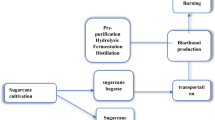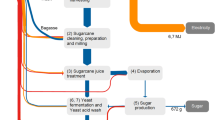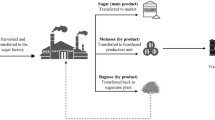Abstract
Purpose
The production of bioethanol in Argentina is based on the sugarcane plantation system, with extensive use of agricultural land, scarce use of fertilizers, pesticides, and artificial irrigation, and burning of sugarcane prior to harvesting. The objective of this paper is to develop a life cycle assessment (LCA) of the fuel ethanol from sugarcane in Tucumán (Argentina), assessing the environmental impact potentials to identify which of them cause the main impacts.
Methods
Our approach innovatively combined knowledge about the main impact pathways of bioethanol production with LCA which covers the typical emission-related impact categories at the midpoint life cycle impact assessment. Real data from the Argentinean industry subsystems have been used to perform the study: S1—sugarcane production, S2—milling process, S3—sugar production, and S4—ethanol production from molasses, honey, or sugarcane juice.
Results and discussion
The results are shown in the three alternative pathways to produce bioethanol. Different impact categories are assessed, with global warming potential (GWP) having the highest impact. So, the production of 1 kg of ethanol from molasses emitted 22.5 kg CO2 (pathway 1), 19.2 kg CO2 from honey (pathway 2), and 15.0 kg CO2 from sugarcane juice (pathway 3). Several sensitivity analyses to study the variability of the GWP according to the different cases studied have been performed (changing the agricultural yield, including economic and calorific allocation in sugar production, and modifying the sugar price).
Conclusions
Agriculture is the subsystem which shows the highest impact in almost all the categories due to fossil fuel consumption. When an economic and calorific allocation is considered to assess the environmental impact, the value is lower than when mass allocation is used because ethanol is relatively cheaper than sugars and it has higher calorific value.




Similar content being viewed by others
References
Asal S, Marcus R, Hilbert JA (2006) Opportunities for and obstacles to sustainable biodiesel production in Argentina. Energy Sustain Dev 10(2):48–58
Brundtland G (1987) Our common future: the World Commission on Environment and Development. Oxford University Press, Oxford
Caro R, Scandaliaris J, Romero ER, Casem S, De Boeck, G, Giardina JA (2009) Preliminary results of project CIUNT 26/A 428: analysis of productivity and sustainability of sugarcane as energy crop in Tucumán and NOA. Universidad Nacional de Tucumán, San Miguel de Tucumán
Cavalett O, Junqueira TL, Dias MOS, Jesus CDF, Mantelatto PE, Cunha MP, Franco H, Cardoso T, Maciel R, Rosell C, Bonomi A (2012) Environmental and economic assessment of sugarcane first generation biorefineries in Brazil. Clean Techn Environ Policy 13(3):399–410
Centre for Environmental Studies (2001) CML 2 baseline method 2000. University of Leiden, Leiden
Centro Azucarero Argentino (2010) Índice de Precios Mayoristas del Azúcar en el Mercado Interno. Available at http://www.centroazucarero.com.ar/precio-mayoris.html. Accessed 1 December 2012
Chauhan MK, Varun, Chaudhary S, Kumar S, Samar (2011) Life cycle assessment of sugar industry: a review. Renew Sustain Energy Reviews 15(7):3445–3453
Cortez LAB, Brossard Pérez LE (1997) Experiences on vinasses disposal. Part III: combustion of vinasse-6 fuel oil emulsions. Braz J Chem Eng. doi:10.1590/S0104-66321997000100002
Edwards R, Larive JF, Beziat JC (2011) Well-to-wheels analysis of future automotive fuels and power trains in the European Context Report. European Commission Joint Research Centre, Institute for Energy. ISBN 978-92-79-21395-3. Available at http://publications.jrc.ec.europa.eu/repository/handle/111111111/22590. Accessed 1 December 2012
Faist M, Pfister S, Koehler A, de Giovanetti L, Arena AP, Zah R (2011) Taking into account water use impacts in the LCA of biofuels: an Argentinean case study. Int J Life Cycle Assess 16(9):869–877
Farrell AE, Plevin RJ, Turner BT, Jones AD, O’Hare M, Kammen DM (2006) Ethanol can contribute to energy and environmental goals. Science 311(5781):506–508
Food Database (FDDB) (2012) Sugar. Available at http://fddb.info/db/en/food/natural_product_sugar/index.html. Accessed 1 December 2012
García CA, Fuentes A, Hennecke A, Riegelhaupt E, Manzini F, Masera O (2011) Life-cycle greenhouse gas emissions and energy balances of sugarcane ethanol production in Mexico. Appl Energy 88(6):2088–2097
Hugot E (1986) Handbook of cane sugar engineering. Elsevier, Amsterdam
International Organization for Standardization (2006a) ISO 14040: environmental management—life cycle assessment principles and framework. International Organization for Standardization, Geneva
International Organization for Standardization (2006b) ISO 14044: environmental management—life cycle assessment—requirements and guidelines. Switzerland, Geneva
Joseph K (2010) Gain report. Argentina. Biofuels annual. USDA Foreign Agricultural Service
Jungbluth N, Chudacoff M, Dauriat A, Dinkel F, Doka G, Faist Emmenegger M, Gnansounou E, Kljun N, Schleiss K, Spielmann M, Stettler C, Sutter J (2007) Life cycle inventories of bioenergy. EcoInvent report no. 17. Swiss Centre for Life Cycle Inventories, Duebendorf
Kostin AM, Guillén-Gosálbez G, Mele FD, Bagajewicz MJ, Jiménez L (2011) A novel rolling horizon strategy for the strategic planning of supply chains. Application to the sugarcane industry of Argentina. Comput Chem Eng 35:2540–2563
Kostin AM, Guillén-Gosálbez G, Mele FD, Bagajewicz MJ, Jiménez L (2012) Design and planning of infrastructures for bioethanol and sugar production under demand uncertainty. Chem Eng Res Des 19(3):359–376
Luo L, van der Voet E, Huppes G (2009) Life cycle assessment and life cycle costing of bioethanol from sugarcane in Brazil. Renew Sust Energ Rev 13(6–7):1613–1619
Mele FD, Kostin A, Guillén-Gosálbez G, Jiménez L (2011) Multiobjective model for more sustainable fuel supply chains. A case study of the sugarcane industry in Argentina. Ind Eng Chem Res 50:4939–4958
Ministerio de Planificación Federal, Inversión Pública y Servicios (2010) Secretaria de Energía. Precios de biocombustibles. Available at http://energia3.mecon.gov.ar/contenidos/verpagina.php?idpagina=3033. Accessed 1 December 2012
Nemecek T, Heil A, Huguenin O, Meier S, Erzinger S, Blaser S, Dux D, Zimmermann A (2007) Life cycle inventories of agricultural production systems. EcoInvent report no. 15, v2.0. Agroscope FAL Reckenholz and FAT Taenikon, Swiss Centre for Life Cycle Inventories, Duebendorf
Nguyen TLT, Gheewala SH (2008) Life cycle assessment of fuel ethanol from cane molasses in Thailand. Int J Life Cycle Assess 13(4):301–311
Olsson L (ed) (2007) Biofuels. Advances in biochemical engineering and biotechnology, vol 108. Springer, Berlin
Ometto AR, Hauschild MZ, Roma WNL (2009) Lifecycle assessment of fuel ethanol from sugarcane in Brazil. Int J Life Cycle Assess 14:236–247
Panichelli L, Dauriat A, Gnansounou E (2009) Life cycle assessment of soybean-based biodiesel in Argentina for export. Int J Life Cycle Assess 14:144–159
Pereira CLF, Ortega E (2010) Sustainability assessment of large-scale ethanol production from sugarcane. J Clean Prod 18(1):77–82
Pérez D, Fandos C, Scandaliaris J, Mazzone L, Soria F, Scandaliaris P (2007) Estación Experimental Agroindustrial Obispo Colombres (EEAOC) technical report 34. Current state and evolution of the productivity of sugarcane cultivation in Tucuman and Argentinean Northwest in 1990–2007
Renouf MA, Pagan RJ, Wegener MK (2011) Life cycle assessment of Australian sugarcane products with a focus on cane processing. Int J Life Cycle Assess 16:125–137
Renouf MA, Wegener MK, Nielsen LK (2008) An environmental life cycle assessment comparing Australian sugarcane with US corn and UK sugar beet as producers of sugars for fermentation. Biomass Bioenerg 32:1144–1155
Seabra JEA, Macedo IC, Chum HL, Faroni CE, Sarto CA (2011) Life cycle assessment of Brazilian sugarcane products: GHG emissions and energy use. Biofuel Bioprod Bior 5(5):519–532
Secretaría de Energía de la Nación (2009) Informe del Sector Eléctrico (Part 1). Available at http://energia3.mecon.gov.ar/contenidos/verpagina.php?idpagina=3368. Accessed 1 December 2012
Swiss Centre for Life-Cycle Inventories, 2009. Ecoinvent V2.1. database. http://www.ecoinvent.org, Dübendorf, Switzerland
Swiss Centre for Life-Cycle Inventories (2010) EcoInvent database v2.2, Dübendorf, Switzerland. Available at http://www.ecoinvent.org. Accessed 1 December 2012
Tomei J, Upham P (2009) Argentinean soy-based biodiesel: an introduction to production and impacts. Energ Policy 37:3890–3898
US Environmental Protection Agency (1996) Report on revisions to 5th edition AP-42, section 1.8, bagasse combustion in sugar mills. US Environmental Protection Agency, Washington, DC
Acknowledgments
The authors wish to acknowledge the support from the Spanish Ministry of Education and Science (CTQ2012-37039-C02, DPI2012-37154-C02-02, and ENE2011-28269-C03-03), the University Nacional de Tucumán, and the Argentinean CONICET.
Author information
Authors and Affiliations
Corresponding author
Additional information
Responsible editor: Vinod K. Sharma
Rights and permissions
About this article
Cite this article
Amores, M.J., Mele, F.D., Jiménez, L. et al. Life cycle assessment of fuel ethanol from sugarcane in Argentina. Int J Life Cycle Assess 18, 1344–1357 (2013). https://doi.org/10.1007/s11367-013-0584-2
Received:
Accepted:
Published:
Issue Date:
DOI: https://doi.org/10.1007/s11367-013-0584-2




